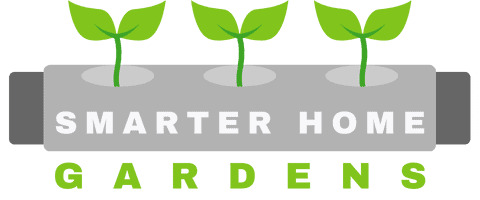
When I started gardening vertically I had no idea just how beneficial it would be for my small, urban garden. Vertical gardening has allowed me to create a green and productive space out of a relatively boring paved back garden. Not only that, but I’m generally spending less time and less money on developing and maintaining it. There are multiple other benefits of vertical gardening:
- Vertical gardens are more sustainable
- You can grow more with less space
- You can grow things anywhere
- Learn about innovative gardening techniques
- They’re easier to maintain
- You get larger crop harvests
- Harvesting is easier
- Better protection from pests
- Better protection from diseases and rot
- You can create beautiful garden art
- Your plants will be cleaner
- Some vertical gardens reduce noise levels
- It can be cheaper than conventional gardening
- It’s easier on your body
Once you understand just how easy it is to create a vertical garden in your home you’ll reap all of these benefits and more. Gone will be the days of disappointing harvests and aggressive weed growth. You’ll have less backbreaking work, and easier plant care and I guarantee you won’t ever feel overwhelmed by it again. Now, let’s get into some of the detail.

If you want to know more, don’t forget to read my ultimate overview of vertical gardening.
The benefits of vertical gardening
1. More sustainable than traditional gardens
Vertical gardening is generally considered more sustainable than conventional gardens for several reasons. A vertical garden takes up much less space but allows you to plant across a wider surface area. This means you can get more plants in a smaller space, which is great for absorbing more carbon dioxide.
When planting horizontally, you have rows of plants with wide gaps of soil (which make up most of the bed). These gaps tend to drink up most of the water and waste the majority of nutrients needed for your plants. By planting vertically into small spots or strips of rich soil, these gaps are eliminated. This helps to dramatically reduce the amount of water that’s needed to keep plants hydrated and topped up with the nutrients they need.
I’ve written an article about how vertical gardens use much less water. Check it out f you like.
Creating a hydroponic system – which doesn’t use any soil at all – further helps to maximize efficiency. And, the less water and soil you need to use, the less you’ll have to buy – saving you money.
I’ve also written an in-depth post on how vertical gardens are sustainable.
2. Grow more with less space
Since vertical gardens are grown upwards instead of outwards they take up far less space than conventional ground-based gardens while increasing the surface area available to plant on. This means that you can grow far more flowers, vegetables, or herbs than you otherwise might on the same patch of ground.
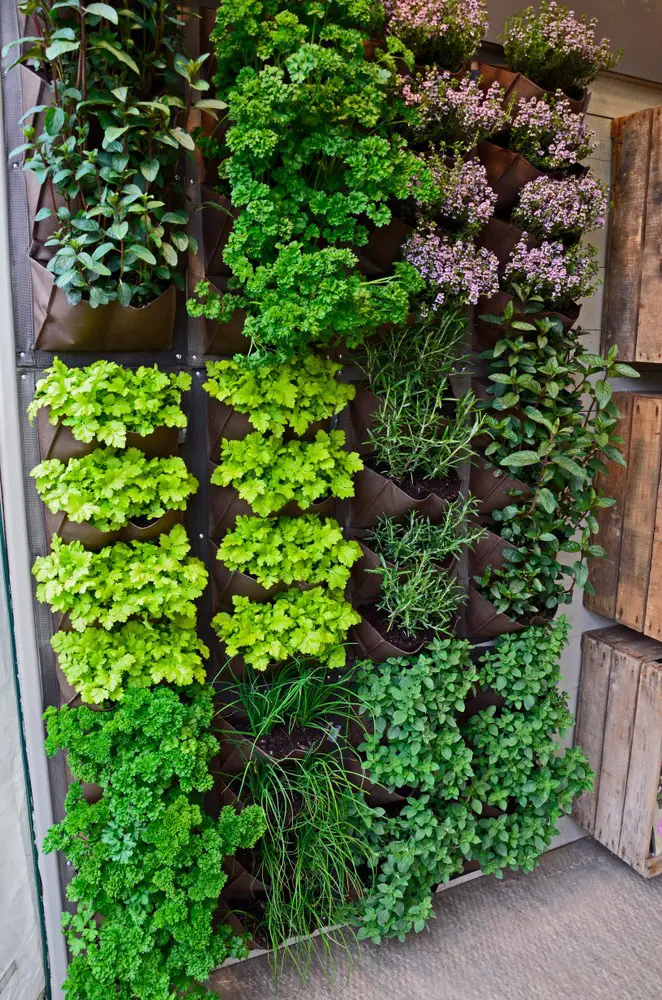
If you live in a city and, like me, scratching your head over how you can maximize the small space you have then vertical gardening could well be the answer. But you don’t need to feel restricted by a small garden to maximize yields. Even those with plenty of space can increase productivity by gardening vertically. I’ve honestly found it amazing just how much you can grow in a relatively small space.
3. Grow things almost anywhere
One of the things I love most about vertical gardening is creativity. Anyone can build a vertical garden anywhere and use almost anything to do it (even empty soda bottles). You have the control to customize your project to fit the most unconventional gardening spaces.
I’m fortunate to have a (small) garden behind my house. But even if you live on the 15th floor of a city high-rise, all hope is not lost. Vertical gardens are great for small spaces like balconies, and even windowsills. Even if you don’t have any outside space, indoor vertical garden systems can still offer a solution. There’s always something that you can make work somewhere.

4. Learn about new gardening techniques
Vertical gardening has fed my love of technology and innovation. It’s all about efficiency and reducing waste while simultaneously maximizing yields. All while creating a system that boosts positive outcomes for the environment. It’s just…clever. And I’ve really enjoyed learning about it.
And, although you can create a vertical garden system from recycled soda bottles, on the high end of the scale the technology gets really interesting. Hydroponics towers, which don’t use any soil at all, are the new craze. The rise of smart garden technologies too, like wifi-enabled watering and fertilizing systems, offer elegant solutions to age-old problems.
If you’re someone who loves 21st-century gardening then there are loads of incredible options to learn about and install.
5. Much easier to maintain
Vertical gardens are much easier to care for compared with conventional gardens. They use much less soil, so there’s far less time spent bending over backward digging in beds. There are fewer garden chores like keeping up with pest control, cleaning leaves, or weeding.
Beds are smaller and easier to prepare. You don’t need to water as much, since less water leeches into the ground. This is especially true if you allow water to drip from the top to the bottom of the system. Keeping your plants topped up with nutrients is easy too as vertical gardening makes foliar feeding (applied directly to the leaves) much more practical.
Check out my related article: Are vertical gardens hard to maintain?
And, because vertical gardens are so easy to maintain, if you struggle with a disability or mobility issues, they could make a great solution.
6. Produce much larger crop harvests
By creating a system that allows you to grow plants upwards rather than outwards you can reduce your total soil footprint while simultaneously increasing the number and density of plants grown.
Put simply, more plants per square foot leads to a greater number of vegetables and a larger harvest. I’ve had incredible success with Tomatoes recently and almost tripled the number we’ve been able to harvest.
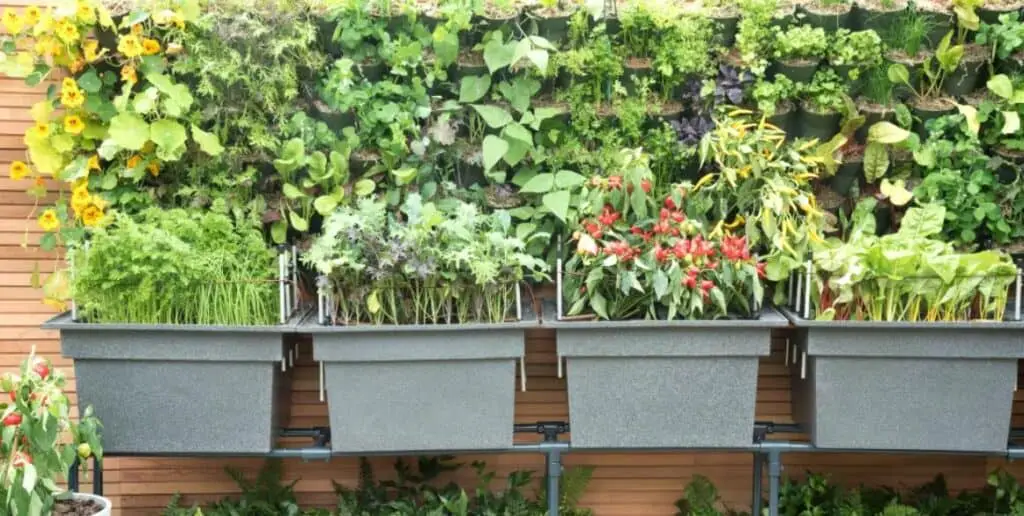
7. Much easier to harvest crops
As well as being able to grow and harvest more plants, herbs, and vegetables, vertical gardening also makes the process of harvesting far simpler. You no longer need to spend hours on your hands and knees digging around in the dirt. Instead, you can simply and easily pull perfect plants directly from their containers, often without bending over at all.
Harvesting is much easier when everything you need is within easy reach. Trust me, your back will thank you!
8. Better protection from pests
I used to have a real problem with snails and slugs. Since starting to garden vertically that problem has pretty much disappeared. Getting plants up and off the ground makes a big difference and keeps them out of reach of any ground-dwelling pests.
I’ve noticed squirrels and birds can still reach the containers, but it’s far easier to protect plants with mesh or protective wire by simply encircling each plant individually.
9. Better protection against diseases
Plants are generally much healthier when grown vertically as opposed to in the ground. This is because most soilborne funguses and diseases find it much more difficult to take hold and spread. This is especially true if you separate each plant completely into its own isolated pocket of soil. Growing plants vertically, especially using a trellis or similar structure, improves airflow around the plants which also helps to reduce disease and keep plants healthy.
10. They can create beautiful facades
Vertical gardens don’t all have to be about growing vegetables or herbs. On approach, the green ‘living’ wall, can be a great way to build beautiful facades of colorful plants that brighten up your garden or even living room.
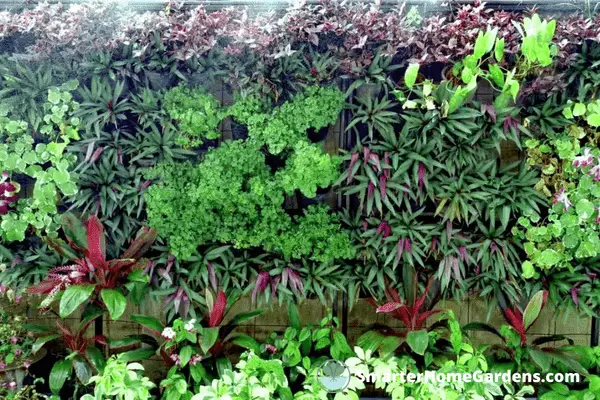
Green walls are an increasingly popular design choice for offices and other urban areas. You may well have seen one before, or work in a building that has one. If done right, they can be utterly beautiful. Additionally, they’re proven to reduce stress and have a measurable positive benefit on the local environment. Green walls can also be a great way to create more private garden spaces, blocking the view of prying eyes.
11. Keep plants much cleaner
It may seem like a small thing but keeping your plants clean (specifically their leaves) is essential. Because plants are raised off the ground in a vertical system, and less soil is used, they are generally kept cleaner than their ground-dwelling counterparts. This keeps them healthier and allows plants to absorb more light through their leaves, suck in more carbon dioxide, and produce more oxygen. It also makes foliar feeding, an efficient way to get nutrients to your plants through their leaves, far easier.
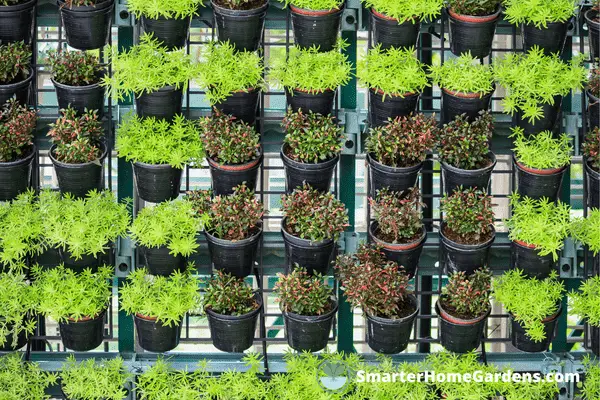
12. Help to reduce noise levels
Speaking of green ‘living’ walls, it has also been proven that they can help to reduce noise pollution. This is partly why so many office buildings in cities create them on their walls. But you can take advantage of the same science too in your garden. A garden that is filled with vegetation, particularly if that vegetation rises high above the ground, can help to reduce the noise around it.
13. Cheaper to set up and run vs. conventional gardens
On top of everything else, vertical gardening can save you money too. They can be built incredibly cheaply out of almost any material. They require less maintenance, less water, and fewer fertilizers. At a time when we’re all feeling the pinch, reducing the number of resources needed to run your garden is a good thing.
Plants are healthier, which means they tend to die less and live longer. And, if you are really serious about it, you can even grow enough vegetables to supplement your weekly shop since vertical gardens are more productive.

Vertical gardening can be a great solution for anyone looking to simplify their gardening experience and increase harvests at a low cost.
14. Much better for your body
When I was a kid, I was a pretty great rower. However, the price of greatness was a messed up back. While conventional gardening wasn’t a massive problem, all the physical effort and contrition certainly weren’t helping. Thankfully, since starting a vertical garden the days of back-breaking tilling, cutting, bending, crawling, and digging are over. My vertical garden is a clean, vertical system that requires virtually no maintenance and my body thanks me for it.
To summarise
Vertical gardening has so many benefits that can help you to grow more food with less space all while saving you a little money and protecting your body from physical stress. Since starting vertical garden it’s hard to see how I would switch back. It’s the perfect way to grow all of the extra herbs and greens I need to support my diet.
If this sounds good to you and you would like to learn more about vertical gardening and how you can get started, read my ultimate overview to vertical gardening.
